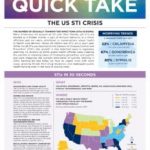 April is STD Awareness Month, an annual observance to raise public awareness about the impact of sexually transmitted diseases (STDs) on the lives of Americans and the importance of preventing, testing for, and treating STDs (also called STIs, which stands for sexually transmitted infections). It is an opportunity to normalize routine STI testing and conversations about sexual health.
April is STD Awareness Month, an annual observance to raise public awareness about the impact of sexually transmitted diseases (STDs) on the lives of Americans and the importance of preventing, testing for, and treating STDs (also called STIs, which stands for sexually transmitted infections). It is an opportunity to normalize routine STI testing and conversations about sexual health.
Today the O’Neill Institute released a new Quick Take document for STD Awareness Month. The document, Quick Take: The US STI Crisis, provides an overview of STIs in the United States. About 20 million new STIs occur each year. While not all STIs are reported to the Centers for Disease Control and Prevention (CDC), the growth in new reported cases is especially alarming. Since 2013, chlamydia, gonorrhea, and syphilis have all sharply increased – with more than two million of these infections reported to the CDC in 2017 alone. From 2013-2017, syphilis increased 80% to 101,567 cases, gonorrhea increased 67% to 555,608 cases, and chlamydia increased 22% to 1.7 million cases.
The Quick Take document discusses trends in STI diagnoses among several groups, including adolescents and young adults, women and infants, gay and bisexual men, transgender people, and racial/ethnic communities, as well as geographic differences in STI burden. Half of all new STI diagnoses are in young people aged 15-24, even though they comprise only a quarter of sexually active people, and young women are particularly vulnerable to STIs. Many STIs disproportionately impact gay and bisexual men. Roughly 2 in 3 cases of primary and secondary syphilis are diagnosed among these men. Transgender people are also at high risk for STIs, but incomplete data on transgender people limits our understanding of STI health inequities related to gender identity. In addition, many minority communities are heavily impacted by STIs, reflecting inequities in social and economic conditions. For chlamydia, Black women are 5.0 times more likely to be diagnosed than white women, and Black men are 6.6 times more likely to be diagnosed than white men.
To reduce the number of STIs, we need to champion the importance of sexual health, including quality sexual health education in school settings. We also need increased investment in STI prevention, care, and treatment. The Quick Take document discusses specific opportunities for innovation in five areas: (1) vaccine development, (2) the treatment pipeline, (3) financing and pricing for STI diagnostics and therapeutics, (4) alternative screening and service delivery, and (5) program integration.
Urgent action is needed to respond to the STI crisis. We can and must do more to prevent and treat STIs.



